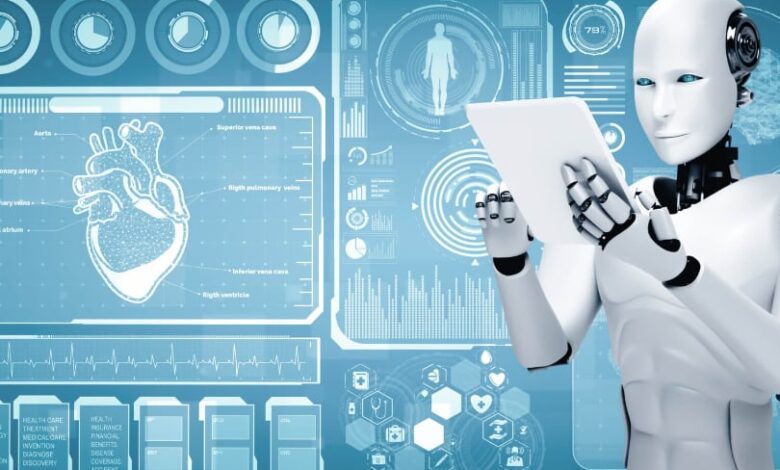The Shift in Healthcare Through AI-Driven Patient Monitoring Systems

With AI powered tools and automation, healthcare is now enabled to provide better standards of patient care and safety. A patient monitoring system powered by AI helps in real-time tracking of health keeping the risk factors in check. The ability to monitor crucial changes through automated health tracking and intelligent patient tracking enables interpretable data insight for hospitals to avert severe health situations. Adoption of these AI tools for hospital management systems enables the broader picture of automation in healthcare to be established and achieved, delivering efficiency and safety in hospitals. In this blog we will discuss the need for AI driven monitoring systems including benefits, applications, and proper implementation into the healthcare sector positively impacting the welfare of the patient.
AI Powered Patient Monitoring Systems For Hospitals
AI powered patient monitoring systems enable the use of machine learning algorithms to constantly monitor several health metrics through a combination of sensors and predictive analytics. The use of remote patient monitoring tools powered through real time analytics puts the healthcare provider in a position to mitigate any potential health risks through the timely addressing of their concerns.
AI patient monitoring integrated into a hospital management system combines patients with their hospital records and facilitates the ability of the providers with the entire relevant available information about a patient. Furthermore, the use of AI chatbots in healthcare enables even patients or caregivers to get timely information or advice over problems, making the care better.
Advantages of the AI Based Patient Monitoring Systems in Hospitals.
AI based monitoring certainly has plenty of advantages to offer to the providers as well as the patients. Such advantages are not just confined to data collection and include the physiologic changes of the way hospitals do business and interact with their patients:
- Better Patient Safety Levels: Patients at risk are continuously monitored and any abnormal patterns are seen and addressed before the worsening of the person’s condition.
- Maximised Resource Utilisation: Monitored automated systems relieve staff from the need to keep watch over patients on the bed, allowing them to only take care of the patient physically.
- Greater Number of Interacted Patients: AI chatbots in healthcare has enabled AI chatbots in healthcare to get regular updates and pieces of advice about their treatment which increases their involvement in their treatment.
- Reduction of Expenses: Prevention and early treatment lowers the chances of a patient needing to be sent back into the hospital, a high-cost intervention, which saves a lot of money in healthcare.
A report issued by MarketsandMarkets claims that AI in healthcare is expected to increase from USD 6.9 billion in 2021 to USD 67.4 billion by 2027, making substantial investments in AI-related innovations that include patient surveillance widespread.
Comprehensive Features of Intelligent Patient Tracking Systems
- Real-Time Patient Monitoring
AI based monitoring systems receive real time information from sensors that are used to check heart beats, blood pressure, oxygen level and respiration rate among other vital signs. When analysed by algorithms, this upholds the norms and alerts the medical personnel in case the conditions are not normal and they need to step in. The addition of real-time patient monitoring capability to a hospital management system guarantees that vital information is always readily available. - Predictive Analytics for Risk Assessment
Applications of predictive analytics in AI patient monitoring systems allow the AI applications to analyse patient data of the past and current patients to highlight possible risks when making a diagnosis. For instance, such patients with a respiratory history may be monitored closely and AI reminds caregivers if there are chances the patient may experience respiratory distress to act on it quickly. - Remote Patient Monitoring Tools
Nowadays, patients aren’t as confined to hospitals as they once were; this is due to remote monitoring tools. Such tools allow patients’ to be observed right from their homes, with their vitals being linked to the doctor on a real-time basis; this tool is quite helpful in preventing the need for any sort of hospitalisation. Such tools can be applied in post-operative care, care for chronic illness and even the elderly.
- Automated Alerts and Notifications
Automated alert systems aid in speeding up critical consternation. With the introduction of AI powered healthcare providers receive notifications about changes in patient’s health automatically. When used with AI Chats in the healthcare system, patients obtain swift treatments by taking immediate recommended actions from the chat.
Real-World Applications of AI-Driven Patient Monitoring

- Intensive Care Units (ICUs)
AI based moderate supervision is essential in environments where stakes are high, for instance, in intensive care units. Vital signs and patterns are monitored uniformly by AI algorithms building the capacity to forecast matters of health such as heart attack and sepsis. The automation in healthcare ICUs guarantees that critical events do not occur as patients have immediate attention when such circumstances arise.
- Caring For Those With Chronic Diseases
The home environment has, in this case, permanently changed the way patients with chronic diseases are treated. Tools powered by AI can monitor diabetes, hypertension, heart and other diseases by tracking symptoms and medication as well as lifestyle choices. There are alerts if any parameters indicate a potential deterioration of the patient’s condition so that he/she can seek medical attention before things get out of control.
- Care After Surgery
Patients after surgery need to be closely watched as they might develop further problems. Monitoring devices powered by AI monitor a patient’s vital signs and parameters of recovery ensuring that the patients are on the right path to recovery. For instance, heart rate or blood pressure can be monitored and recorded at home maintaining contact with a health provider.
- Elderly and Assisted Living Care
Patients older in age need close supervision in order to keep them in good shape and to make sure that they do not fall. AI powered monitoring devices that have fall detection and smart patient tracking features allow caregivers to act fast in emergencies. This gives elderly patients more freedom while ensuring their safety.
Making Healthcare Safer with Real Time Patient Tracking
A real time patient tracking system should be considered the perfect gadget to avoid setbacks in busy hospital working routines. A sufficient distance from a patient or their constant movement makes it very challenging for the staff to constantly monitor the patient. Artificial intelligence patient tracking systems include:
- Reduced Waiting Time for Treatment: The moment critical signs are registered, notifications are sent to the designated healthcare personnel, therefore chances of waiting time amplifying are minimised.
- Medications Getting Overlooked and Mistakes in Treatment is Avoided: Regular automation tracks down the routine of patients, thus ensuring that every patient is given their prescribed medications within the given time.
- More Open and Clear Communication: Data and information are continuously being collected through real time tracking, this information becomes available to the healthcare team keeping the transparency in the care intact as well as enabling thorough evaluation in case of a handover of the patient.
As per the WHO data around each ten admissions to almost every hospital around the world represents a scenario where a patient would have to go through a debatable and preventable negative incident. AI based monitoring systems have the potential to avoid these negative occurrences from the very beginning allowing an event to be completely under control before it occurs.
Integrating AI Monitoring Systems in Healthcare Facilities
Now, deploying an AI patient monitoring system in a healthcare facility is very easy once the hospital goes through the following steps and structures the technology according to their infrastructure and aims to achieve.
- The Initial Step is to Analyse and Set the Targets and Goals
To begin with, look at the requirements available at your own healthcare facility, which new patients or demographic do you seek to target, and what are your main aims and objectives such as looking for narrowing readmissions, seeking for improved management of patients with chronic diseases, or an effective IC unit, etc. Ensure you have precise aims, as this will help when choosing and utilising the monitoring system. - Use an Appropriate Artificial Intelligence Monitoring Network
The monitoring system adopted in the hospital should be capable of fulfilling the needs of the facility. Including features such as real time monitoring, remote access and research as well as storage of the data. Investigate whether the hospital’s management system works in coordination with the program. - Verifying Key Practices Supplied to Data security would ensure Efficient security intervention.
Data privacy remains a significant consideration especially for health information. Deploy monitoring systems that strengthen compliance on data protection such as HIPAA and GDPR. Also check whether the program encompasses encryption, access control and auditing functionalities designed to protect sensitive data about the patients from exploitation.
Implement AI Chatbots to Talk to Patients
From the issues faced in AI Chatbots in Healthcare, it is obvious that these chatbots can assist in watching over patients. They inform patients of changes, remind them of items, answer standard questions regarding symptoms and treatment offered. Their input in encouraging patients’ participation and self-management is crucial especially for managed care for patients at a distance.
- Run a Pilot with Testing and Train Employees
Conduct a pilot testing with a selected number of patients and a staff before going for a surgical operation to all. Use this phase to troubleshoot potential issues, gather feedback and modifications to the system may be done in accordance with the feedback. Ensure that staff is taught how to use this system, what to do when common problems arise and how to communicate with patients.
- Oversee System Performance and Enhance it Intimately
The performance of the system must also be monitored, to understand whether it is enough or appropriate for the needs of the hospital. Evaluate response times, alert and patient feedback or satisfaction’s, updating those metrics with irregular frequency. Focussing on these factors will permit the hospitals to enjoy the full advantages of AI patient assessment.
User Experience: In What Ways AI Monitoring Patients Affects the Quality of Care Delivered
AI patient monitoring tools indeed improve the experience of the patients. ‘I feel safe and at ease because the system is watching over me, and if there is a problem, the problem will raise the alarm ’ is the general sentiment I get from the patients. Even those using remote patient monitoring tools’ do have AI addressed concerns in their minds, but the technology enables them to manage their health from the comfort of their homes.
These systems also cut down the time for the patient to wait for emergency response in case of busy hospitals, where the health care employees are trained to deal with the emergency cases. In addition, the internet and social media, in conjunction with healthcare AI Chatbots, provide patients ready access to updates on their health, making the care experience so more proactive in care and effective in supply.
Conclusion
AI-driven patient monitoring systems are starting to push the boundaries of healthcare as they provide information and insights usable for action in their care. Intelligent patient monitoring systems help hospitals to meet the demand of patients in a timely and safe manner, preventing avoided events and improving throughout. Hospitals make sure that AI monitoring technology is implemented in a ‘sensible fashion’ and that staff and patients’ requirements will be met. In summary, AI patient monitoring, together with AI chatbots in healthcare and other automation in healthcare devices will help to shape a more effective, more responsive, and more patient’s oriented healthcare environment.
FAQs on Artificial Intelligence in Patient Care Monitoring to Enhance Quality and Precision in Care Delivery
Q: What role does Ai-powered patient monitoring have to play in hospitals?
A: According to nihr.ac.uk, Ai-powered patient monitoring increases safety, allows for health risk to be detected early enough, decreases the chances of readmission, and assists in enhancing efficiency in operational processes by AI doing the monotonous monitoring processes every moment.
Q: What other areas apart from securing a patient’s life does real-time monitoring of patients tracking systems serve?
A: Distortion of time in response, human error in treatment as well as unnecessary supervision are the things that real time tracking eliminates and indeed enhances a system whereby patients are safe and quality of care is superb.
Q: What steps are required to implement AI-driven monitoring in healthcare facilities?
A: It encompasses, to begin with, requirements analysis of the hospital, selection of a fitting monitoring redesign, data protection, deployment of AI chatbots, running of pilot experiments, and regular optimization of output.
Q: How does AI monitoring integrate within a hospital management system?
A: AI monitoring systems integrated with hospital management systems use patient records entered in real time into the hospital from the department to monitor and analyse the information flow processes within the organisation.



